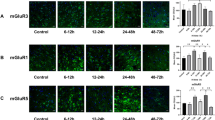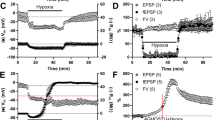Abstract
The potassium-stimulated release of acetylcholine (ACh), glutamate (GLU) and dopamine (DA) from mouse striatal slices was studied during anoxia and/or 3,4-diaminopyridine (DAP) treatment. Anoxia, in the presence of calcium, increased DA and GLU release, but depressed ACh release. Omission of calcium from an anoxic incubation further stimulated GLU and DA release and impaired ACh release. Under normoxic conditions, DAP (100 μM) increased the release of all three neurotransmitters; the sensitivity of the slices to DAP changed with the presence or absence of an acetylcholinesterase inhibitor in the preincubation media. During an anoxic incubation, DAP did not ameliorate the anoxic-induced, K+-stimulated impairment of ACh release, but significantly reduced the K+-stimulated release of GLU and DA. These results are consistent with the hypothesis that hypoxia induces a presynaptic deficit that may underlie postsynaptic ischemic-induced changes. Amelioration of these presynaptic alterations in neurotransmitter release may be an effective approach to preventing hypoxic-induced damage.
Similar content being viewed by others
References
Luft, U. C. 1965. Aviation physiology-The effects of altitude. Pages 1099–1145,in Fenn, W. O. and Rahn, H. (eds.), Handbook of Physiology, Vol. 2, Sec. 3: Respiration, American Physiological Society, Washington, D.C.
Siesjo, B. K. 1978. Page 398, Brain Energy Metabolism, Wiley, New York.
Gibson, G. E., Pulsinelli, W., Blass, J. P., and Duffy, T. E. 1981. Brain dysfunction in mild to moderate hypoxia. Amer. J. Med. 70:1247–1254.
Gibson, G. E., and Peterson, C. 1982. Decreases in the release of acetylcholine with low oxygen in vitro. Biochem. Pharmacol. 31:111–115.
Hirsch, J. A., and Gibson, G. E. 1984. Selective alteration of neurotransmitter release by low oxygen in vitro. Neurochem. Res. 9:1039–1049.
Freeman, G. B., and Gibson, G. E. 1986. Effects of decreased oxygen on in vitro release of endogenous dopamine from mouse striatum. J. Neurochem. 47:1924–1931.
Patuszko, A., Wilson, D. F., and Erecinska, M. 1982. Neurotransmitter metabolism in rat brain synaptosomes: effect of anoxia and pH. J. Neurochem. 38:1657–1667.
Peterson, C., and Gibson, G. E. 1984. Synaptosomal calcium metabolism during hypoxia and 3,4-diaminopyridine treatment. J. Neurochem. 42:248–253.
Lundh, H., and Thesleff, S. 1977. The mode of action of 4-aminopyridine and guanidine on transmitter release from motor nerve terminals. Eur. J. Pharmacol. 42:411–412.
Glover, W. E. 1978. Potentiation of vasoconstriction by 3-and 4-aminopyridine. Br. J. Pharmacol. 63:577–585.
Katz, B., and Miledi, R. 1969. Spontaneous and evoked activity of motor nerve endings in calcium Ringers. J. Physiol. (Lond.) 203:689–706.
Katz, B., and Miledi, R. 1979. Estimates of quantal content during “chemical potentiation” of transmitter release. Proc. R. Soc. London B. Biol. Sci. 205:369–378.
Peterson, C., and Gibson, G. E. 1982. 3,4-diaminopyridine alters acetylcholine metabolism and behavior during hypoxia. J. Pharmacol. Exp. Ther. 222:576–582.
Tapia, R., and Sitges, M. 1982. Effect of 4-aminopyridine on transmitter release in synaptosomes. Brain Res. 250:291–299.
Itoh, T., and Quastel, J. H. 1970. Acetoacetate, metabolism in infant and adult rat brain in vitro. Biochem. J. 116:641–655.
Lowry, O. H., and Passonneau, J. V. A Flexible System of Enzymatic Analysis, Academic Press, New York, 1972.
Freeman, J., Choi, R., and Jenden, D. J. 1975. Plasma choline: its turnover and exchange with brain choline. J. Neurochem. 24:729–734.
Gornall, A. G., Bardawill, C. J., and Davis, M. 1949. Determination of serum proteins by means of the biuret reaction. J. Biol. Chem. 1778:751–766.
Steele, R. G. D., and Torrie, J. H. 1960. Principles and Procedurs of Statistics. McGraw-Hill, New York.
Winer, B. J. 1971. Statistical Principles of Experimental Designs, McGraw-Hill, New York.
Johnston, M. V. 1983. Neurotransmitter alterations in a model of perinatal hypoxic-ischemic brain injury. Annals Neurol. 13:511–518.
Francis, A., and Pulsinelli, W. 1982. The response of GABAergic and cholinergic neurons to transient cerebral ischemia. Brain Res. 243:271–278.
Francis, A., and Pulsinelli, W. 1983. Increased binding of [3H]GABA to striatal membranes following ischemia. J. Neurochem. 40:1497–1499.
Vulto, A. G., Sharp, T., and Ungerstedt, U. 1985. Rapid post-mortal increase in extracellular concentration of dopamine in the rat as assessed by intra-cranial dialysis. Soc. Neurosci. Abstr. 11:353.7.
Clemens, J. A., Phebus L. A., Fuller, R. W., and Perry, K. W. 1984. Brain anoxia or breakdown of membrane ionic gradient releases neuronal stores of dopamine in the rat. Soc. Neurosci. Abstr. 10:277.6.
Weinberger, J., and Cohen, G. 1982. The differential effect of ischemia on the active uptake of dopamine, gamma-aminobutyric acid, and glutamate by brain synaptosomes. J. Neurochem. 38:963–968.
Weinberger, J., and Cohen, G. 1983. Nerve terminal damage in cerebral ischemia: greater susceptibility of catecholamine nerve terminals relative to serotonin nerve terminals. Stroke 14:986–989.
Freeman, G. B., Nielsen, P., and Gibson, G. E. 1986. Monoamine neurotransmitter metabolism and locomotor activity during chemical hypoxia. J. Neurochem. 46:733–738.
Benveniste, H., Drejer, J., Schousboe, A., and Diemer, N. H. 1984. Elevation of extracellular concentrations of glutamate and aspartate in rat hippocompus during transient cerebral ischemia monitored by intracerebral microdialysis. J. Neurochem. 43:1369–1374.
Benveniste, H., Drejer, J., Schousboe, A., and Diemer, N. H. 1984. Excitatory amino acids and ischemic brain damage. Acta. Neurol. Scand. 69:336.
Bosley, T. M., Woodhams, P. L., Gordon, R. D., and Balazs, R. 1983. Effects of anoxia on the stimulated release of amino acid neurotransmitters in the cerebellum in vitro. J. Neurochem. 40:189–201.
Drejer, J., Benveniste, H., Diemer, N. H., and Schousboe, A. 1985. Cellular origin of ischemia-induced glutamate release from brain tissue in vivo and in vitro. J. Neurochem. 45:145–151.
Arnfred, T., and Hertz, L. 1971. Effects of potassium and glutamate on brain cortex slices: uptake and release of glutamic and other amino acids. J. Neurochem. 18:259–265.
Mykytyn, V., and Gibson, G. E. 1985. In vitro anoxia selectively damages striatal and hippocampal acetylcholine and carbon dioxide production. Soc. Neurosci. Abstr. 11: 261.
Griffiths, S. T., Evans, M. C., and Meldrum, B. S. 1983. Intracellular calcium accumulation in rat hippocampus during seizures induced by bicuculline orl-allylglycine. Neurosci. 10:385–395.
Simon, R. P., Griffiths, T., Evans, M. C., Swan, J. H., and Meldrum, B. S. 1984a. Calcium overload in selectively vulnerrable neurons of the hippocampus during and after ischemia: an electron microscopy study in the rat. J. Cereb. Blood Flow Metab. 4:350–361.
Simon, R. P., Swan, J. H., Griffiths, T., and Meldrum, B. S. 1984b. Blockade of n-methyl-d-aspartate receptors may protect against ischemic-damage in the brain. Science 226:850–852.
Rothman, S. M., and Olney, J. W. 1986. Glutamate and the pathophysiology of hypoxic-ischemic brain damage. Ann. Neurol. 19:105–111.
Weinberger, J., Nieves-Rosa, J., and Cohen, G. 1985. Nerve terminal damage in cerebral ischemia: protective effect of alpha-methyl-para-tyrosine. Stroke 16:864–870.
Globus, M. Y.-T., Ginsberg, M. D., Busto, R., Harik, S. I., and Dietrich, W. D. 1986. The relationship between striatal dopamine activity, glucose metabolism and blood flow following transient forebrain ischemia in the rat. Soc. Neurosci. Abstr. 340.11.
Rowlands, G. J., and Roberts, P. J. 1980. Specific calcium-dependent release of endogenous glutamate from rat striatum is reduced by destruction of the cortico-striatal tract. Exp. Brain Res. 39:239–240.
Wieloch, T., Engelsen, B., Westerberg, E., and Auer, R. 1985. Lesions of the glutamatergic cortico-striatal projections in the rat ameliorate hypoglycemic brain, damage in the striatum. Neurosci. Lett. 58:25–30.
Wieloch, T. 1985. Hypoglycemia-induced neuronal damage prevented by an n-methyl-d-aspartate antagonist. Science 230:681–683.
Rothman, S. 1984. Synaptic release of excitatory amino acid neurotransmitter mediates anoxic neuronal death. J. Neurosci. 4:1884–1891.
Alberch, J., Marsal, J., and Solsona, C. 1985. Modulation of the endogenous acetylcholine release from rat striatal slices. Brain Res. 346:353–356.
Baud, P., Arbilla, S., and Langer, S. Z. 1985. Inhibition of the electrically evoked release of [3H]acetylcholine in rat striatal slices: an experimental model for drugs that enhance dopaminergic neurotransmission. J. Neurochem. 44:331–337.
Scatton, B. 1982. Effects of dopamine agonists and neuroleptic agents on striatal acetylcholine transmission in the rat: evidence against dopamine receptor multiplicity. J. Pharmacol. Exp. Ther. 220:197–202.
Lehmann, J., Smith, R. V., and Langer, S. Z. 1983. Stereoisomers of apomorphine differ in affinity and intrinsic activity at presynaptic dopamine receptors modulating [3H]dopamine and [3H]acetylcholine release in slices of cat caudate. Eur. J. Pharmacol. 88:81–88.
Arbilla, S., Bianchetti, G., Galzin, A. M., Langer, S. Z., Morselli, P. L., and Nowak, J. Z. 1983. Chronic haloperidol produces supersensitivity of dopamine receptors modulating3H-DA but not3H-ACh release in the rabbit caudate. Br. J. Pharmacol. 78:16 p.
Nielsen, P. E., and Gibson, G. E. 1986. Mitochondrial and plasma membrane potentials during anoxia and normoxia. Soc. Neurosci. Abstr. 380.9.
Nicholls, D. G., and Akerman, K. E. O. 1982. Mitochondrial calcium uptake. Biochem. Biophys. Acta. 683:57–88.
Peterson, C., Nicholls, D. G., and Gibson, G. E. 1985. Subsynaptosomal calcium distribution during hypoxia and 3,4-diaminopyridine treatment. J. Neurochem. 45:1779–1790.
Nordstrom, O., Braesch Andersen, S., and Bartfai, T. 1986. Dopamine release is enhanced while acetylcholine release is inhibited by nimodipine (Bay e 9736). Acta. Physiol. Scand. 126:115–120.
Vizi, E. S., Van Dijk, J., Foldes, F. F. 1977. Effect of 4-aminopyridine on acetylcholine release. J. Neural. Transm. 41:265–274.
Romero, P. J., and Whittman, R. 1971. The control by internal calcium of membrane permeability to sodium and potassium. J. Physiol. (Lond.) 214:481–507.
Meech, R. W. 1978. Calcium dependent potassium activation in nervous tissues. Ann. Rev. Biophys. Bioenerg. 7:1–18.
Poli, A., Contestabile, A., Migani, P., Rossi, L., Rondelli, C., virgilli, M., Bissoli, R., and Barnabei, O. 1985. Kainic acid differentially affects the synaptosomal release of endogenous and exogenous amino acid neurotransmitters. J. Neurochem. 45:1677–1686.
Author information
Authors and Affiliations
Rights and permissions
About this article
Cite this article
Freeman, G.B., Mykytyn, V. & Gibson, G.E. Differential alteration of dopamine, acetylcholine, and glutamate release during anoxia and/or 3,4-diaminopyridine treatment. Neurochem Res 12, 1019–1027 (1987). https://doi.org/10.1007/BF00970931
Accepted:
Issue Date:
DOI: https://doi.org/10.1007/BF00970931




